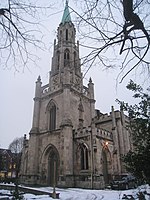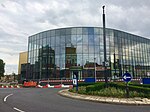City of Doncaster

The City of Doncaster is a metropolitan borough with city status in South Yorkshire, England. It is named after its principal settlement, Doncaster, and includes the surrounding suburbs of Doncaster as well as numerous towns and villages. The district has large amounts of countryside; at 219 square miles (570 km2), it is the largest metropolitan borough in England by area. The largest settlement in the borough are Doncaster itself, followed by the towns of Thorne, Hatfield and Mexborough (the latter of which is part of the Barnsley/Dearne Valley built-up area), and it additionally covers the towns of Conisbrough, Stainforth, Bawtry, Askern, Edlington and Tickhill. Doncaster borders North Yorkshire to the north, the East Riding of Yorkshire to the north-east, North Lincolnshire to the east, Bassetlaw in Nottinghamshire to the south-east, Rotherham to the south-west, Barnsley to the west, and Wakefield, West Yorkshire, to the north-west. It is part of the Yorkshire and the Humber region. The borough was created on 1 April 1974, under the Local Government Act 1972, as a merger of the former County Borough of Doncaster, the urban districts of Adwick-le-Street, Bentley with Arksey, Conisbrough, Mexborough, and Tickhill, Doncaster and Thorne rural districts, and the parish of Finningley from East Retford Rural District and small parts of the parish of Harworth from Worksop Rural District from Nottinghamshire.
Excerpt from the Wikipedia article City of Doncaster (License: CC BY-SA 3.0, Authors, Images).City of Doncaster
Prince's Street, Doncaster Hyde Park
Geographical coordinates (GPS) Address Nearby Places Show on map
Geographical coordinates (GPS)
| Latitude | Longitude |
|---|---|
| N 53.5225 ° | E -1.1286111111111 ° |
Address
Iceland
Prince's Street
DN1 3NJ Doncaster, Hyde Park
England, United Kingdom
Open on Google Maps







